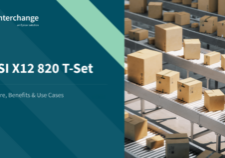855 T-Set: Structure, Benefits & Use Cases
Electronic Data Interchange (EDI) has become an essential component for efficient business communications and transactions across various industries. One such critical transaction set under the ANSI X12 EDI standard is the EDI 855. This set is vital for managing purchase order acknowledgments, ensuring smooth and precise communication between trading partners.
In this blog, we will delve into the structure, benefits, and practical applications of the EDI 855 transaction set, helping businesses understand its importance and how to leverage it for better operational efficiency.
What is the ANSI X12 EDI 855 T-Set?
The ANSI X12 EDI 855 T-Set, also known as the Purchase Order Acknowledgement, is a standardised electronic document used by suppliers to confirm the receipt and details of a purchase order (PO) from a buyer. This acknowledgment indicates whether the supplier can fulfil the order as specified, and if not, it communicates any changes or issues that need to be addressed.
As part of the ANSI X12 EDI standards developed by the American National Standards Institute, the EDI 855 ensures a uniform method for exchanging order acknowledgments across different systems and organisations. By using this transaction set, businesses can automate and streamline their order processing, reducing the likelihood of errors and misunderstandings.
Common use cases for the ANSI X12 EDI 855 T-Set
The versatility of the EDI 855 T-Set makes it valuable across various industries. Here are some common use cases:
- Retail:
- Confirms purchase orders from retailers to suppliers.
- Ensures better inventory management and planning.
- Crucial for maintaining stock levels during peak seasons or promotional events.
- Manufacturing:
- Manages orders for raw materials, components, and finished goods.
- Coordinates production schedules and ensures timely delivery of materials.
- Helps maintain continuous production cycles and reduces downtime due to material shortages.
- Healthcare:
- Confirms orders for medical supplies, equipment, and pharmaceuticals.
- Ensures timely acknowledgments to maintain necessary items for patient care.
- Supports efficient supply chain operations and regulatory compliance.
- Automotive:
- Acknowledges orders for parts and components used in vehicle manufacturing.
- Assists in managing complex supply chains with multiple suppliers.
- Enhances coordination between manufacturers and suppliers to avoid production delays.
- E-commerce:
- Confirms online retailers’ orders with their suppliers.
- Helps manage inventory levels and avoid stockouts.
- Ensures accurate and timely order fulfilment, enhancing customer satisfaction.
Benefits of implementing the ANSI X12 EDI 855 T-Set
Adopting the EDI 855 T-Set offers numerous advantages that can significantly impact a business’s operational efficiency. Here are some key benefits:
- Improved communication: Facilitates clear and timely communication between buyers and suppliers.
- Enhanced accuracy: Automates the acknowledgment process, reducing the need for manual data entry and minimising risk of human error.
- Increased efficiency: Allows suppliers to quickly confirm order details and address any issues, resulting in faster fulfilment times.
- Better order management: Helps buyers manage their orders more effectively, facilitating better planning and informed purchasing decisions.
- Cost reduction: Reduces the need for paper-based documentation and manual intervention, lowering administrative costs.
- Stronger supplier relationships: Builds trust and transparency between trading partners through accurate and timely acknowledgments.
- Regulatory compliance: Ensures adherence to industry standards and regulatory requirements. Also facilitates audit trails and documentation for compliance purposes, reducing the risk of non-compliance penalties.
By integrating the EDI 855 T-Set into their operations, businesses can achieve greater accuracy, efficiency, and cost-effectiveness in their order management processes.
Example of an ANSI X12 EDI 855 T-Set
Let’s illustrate what you can expect out of using the ANSI X12 EDI 955 T-Set with an example:
| ST*855*0001~ BAK*00*AC*123456789*20240518~ REF*PO*987654321~ DTM*002*20240518~ N1*BY*Buyer Company*92*12345~ N1*SE*Supplier Company*92*67890~ PO1*1*100*EA*15.00*PE*VN*123-ABC-456~ PID*F****Widget A~ PO1*2*50*EA*20.00*PE*VN*123-DEF-789~ PID*F****Widget B~ CTT*2~ SE*10*0001~ |
Here is a breakdown of what each of the above segments mean:
| Segment | Example | Description |
| ST | ST*855*0001~ | Transaction Set Header: Indicates the start of the transaction set (855 for Purchase Order Acknowledgment) and includes a control number for reference. |
| BAK | BAK*00*AC*123456789*20240518~ | Beginning Segment for Purchase Order Acknowledgment: Provides information about the acknowledgment, including the purpose (00 for original), the acknowledgment type (AC for acknowledgment), the purchase order number, and the date. |
| REF | REF*PO*987654321~ | Reference Identification: Transmits the purchase order number for reference. |
| DTM | DTM*002*20240518~ | Date/Time Reference: Specifies the date relevant to the transaction, such as the acknowledgment date. |
| N1 | N1*BY*Buyer Company*92*12345~ | Buyer Name: Identifies the buyer by name and an identification code. |
| N1 | N1*SE*Supplier Company*92*67890~ | Supplier Name: Identifies the supplier by name and an identification code. |
| PO1 | PO1*1*100*EA*15.00*PE*VN*123-ABC-456~ | Purchase Order Line Item: Details the first line item being acknowledged, including the line item number, quantity, unit of measure, price, and product identifier. |
| PID | PID*F****Widget A~ | Product/Item Description: Provides a description of the product or item. |
| PO1 | PO1*2*50*EA*20.00*PE*VN*123-DEF-789~ | Purchase Order Line Item: Details the second line item being acknowledged, including the line item number, quantity, unit of measure, price, and product identifier. |
| PID | PID*F****Widget B~ | Product/Item Description: Provides a description of the second product or item. |
| CTT | CTT*2~ | Transaction Totals: Indicates the total number of line items in the transaction. |
| SE | SE*10*0001~ | Transaction Set Trailer: Ends the transaction set and includes the total number of segments (10) and matches the control number in the ST segment. |
How is the ANSI X12 EDI 855 T-Set processed?
The processing of the ANSI X12 EDI 855 T-Set involves several crucial steps to ensure accurate and efficient communication between buyers and suppliers. Here is a detailed breakdown of the typical workflow:
- Receipt of Purchase Order (EDI 850): The process begins when the supplier receives a purchase order (EDI 850) from the buyer. This document contains details about the items ordered, quantities, prices, and delivery schedules.
- Review of Purchase Order: The supplier reviews the purchase order to verify the details, including product availability, pricing, and delivery timelines. This step ensures that the supplier can fulfil the order as requested by the buyer.
- Preparation of EDI 855: Based on the review, the supplier prepares the EDI 855 Purchase Order Acknowledgment. This document confirms whether the supplier can meet the order requirements or if there are any changes or issues that need to be communicated.
- Inclusion of detailed information: The EDI 855 includes detailed information such as the acknowledgment of the order, any changes to quantities or prices, expected delivery dates, and any other relevant details. This information ensures that both parties are aligned on the terms of the order.
- Transmission of EDI 855: Once prepared, the EDI 855 is transmitted electronically to the buyer using secure EDI transmission protocols. This secure transmission ensures data integrity and confidentiality.
- Receipt and integration by buyer: Upon receiving the EDI 855, the buyer’s system processes the acknowledgment. The buyer integrates the acknowledgment data into their internal systems, such as ERP or order management systems, to update the status of the purchase order.
- Review and action by buyer: The buyer reviews the EDI 855 to confirm the details and address any changes or issues indicated by the supplier. If there are discrepancies, the buyer may need to communicate further with the supplier to resolve them.
- Order fulfilment: Based on the confirmed details in the EDI 855, the supplier proceeds with order fulfilment. This includes picking, packing, and shipping the items as per the agreed terms.
- Confirmation of shipment (EDI 856 and EDI 810): After the order is shipped, the supplier may send an EDI 856 (Advanced Shipping Notice) to inform the buyer about the shipment details. An EDI 810 (Invoice) may also be sent to request payment for the shipped goods.
- Update of internal systems: Both parties update their internal systems to reflect the latest status of the order. This step ensures that inventory levels, financial records, and order statuses are accurate and up-to-date.
- Documentation and record-keeping: Both the buyer and supplier maintain records of the EDI transactions for future reference, auditing, and compliance purposes. Proper documentation ensures a clear trace of the communication and agreements made.
By following these steps, businesses can ensure the smooth and efficient processing of the ANSI X12 EDI 855 T-Set, leading to improved order management, better supplier relationships, and enhanced operational efficiency.
What are the equivalents of the ANSI X12 EDI 855 T-Set in other standards?
The ANSI X12 EDI 855 T-Set has equivalents in various other electronic data interchange (EDI) standards, which serve similar purposes in different regions or industries. Understanding these equivalents is crucial for businesses operating internationally or with partners using different EDI standards.
Here’s a table outlining the equivalents of the EDI 855 across different EDI standards:
| EDI Standard | Equivalent of ANSI X12 EDI 855 |
| UN/EDIFACT | ORDRSP (Order Response) |
| TRADACOMS | CONORD (Order Confirmation) |
| EANCOM | ORDRSP (Order Response) |
| VDA | 4905 (Delivery Request) / 4913 (Dispatch Advice) |
| Odette | ORDRSP (Order Response) |
These equivalents serve similar functions as the ANSI X12 EDI 855 T-Set, facilitating the communication of purchase order acknowledgments and ensuring that both parties are aligned on the terms of the order. By understanding these equivalents, businesses can better manage their EDI transactions across different standards and ensure smooth international operations.
How best to implement the ANSI X12 EDI 855 T-Set
Implementing the ANSI X12 EDI 855 T-Set effectively requires a robust strategy and the right technology. To fully leverage the benefits of the EDI 855, businesses should integrate it seamlessly into their existing systems, ensure accurate data exchange, and maintain compliance with industry standards. Working with experienced EDI service providers can streamline this process and mitigate potential challenges.
At Data Interchange, we offer advanced EDI software solutions and expert support to help you implement the ANSI X12 EDI 855 T-Set with ease. Our team is dedicated to ensuring that your EDI operations are efficient, accurate, and fully compliant. Ready to enhance your order management processes and improve your supply chain efficiency? Contact one of our experts today to get started.



























































































































